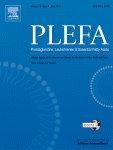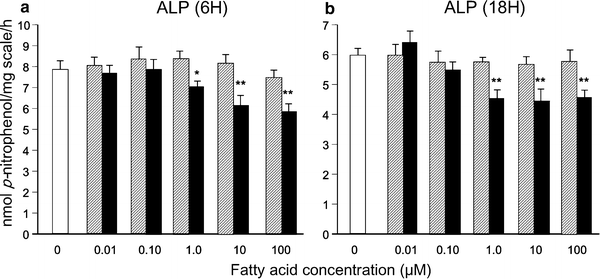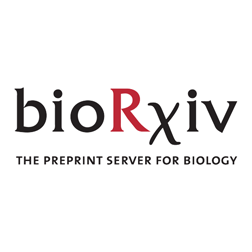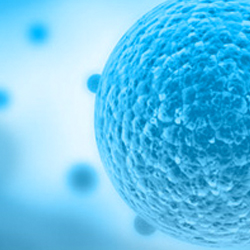D
Deleted member 3990
Kraken
- Joined
- Nov 19, 2019
- Posts
- 8,313
- Reputation
- 15,373
"Synthesis of Mead acid
In animals, it can be produced de novo from oleic acid (18:2n-6).
The enzymes that catalyze the conversion of oleic acid (18:1n-9), linoleic acid (18:2n-6) and alpha-linolenic acid (18:2n-3) to the C20 n-9, omega-6 polyunsaturated fatty acids and omega-3 polyunsaturated fatty acids are the same but omega-6 and omega-3 families have greater affinity for them than does the omega-9; from a biochemical point of view this is competitive inhibition.
In essential fatty acid deficiency competitive inhibition is lack and enzymes will desaturate oleic acid to 18:2n-9 (Δ6 desaturase), which is further elongated and Δ5 desaturated to form Mead acid."


N-methyl-N-nitrosourea (MNU)-induced mammary cancers in Mead Acid (MA) Group and the Control (CTR) Group




(lymph node part is fairly interesting; something to investigate on)




"Intermediate in potency is the Mead acid (20∶3ω−9) product, having roughly ten times less the chemoattractant potency on neutrophils. You might assume that this would be called leukotriene B₃.
The lipoxygenase product of Mead acid had been presumed before it's been found in vivo due to the mythological nature of the beast. Since the de novo formation of Mead acid—an elongation product of oleic acid—requires the near-complete avoidance of all ω−6 fatty acids, Mead acid is generally not found in modern humans; nor is this found in lab animals fed the standard diet, and hence neither is its cycloxygenase product or the leukotriene derived from it. For this reason, the chemical structure of leukotriene B₃ was extrapolated from those of leukotrienes B₃ and B₅. This leukotriene has been synthesized, is an available research chemical, and has been used in white blood cell migration assays—among other assay types—where it gives comparable potency as our maligned leukotriene B₄ ultimately derived from linoleic acid.
In the early 1980s, the presumed Mead acid derivative leukotriene B₃ was found to be a unicorn. The structure extrapolated from the other, more common B-series leukotrienes contains one trans double bond; although this molecule is actually made my Mead acid through lipoxygenase, this is a relatively minor isomer. The actual main products of Mead acid + lipoxygenase are two enantiomers both having three cis double bonds having the IUPAC designations of 5S,12R-dihydroxy-6Z,8Z,10Z-eicosatrienoic acid and 5S,12S-dihydroxy-6Z,8Z,10Z-eicosatrienoic acid. I use the term all-cis-leukotriene B₃ to differentiate it from is unphysiological presumption, which goes by the names of: trans-leukotriene B₃, unicorn-leukotriene B₃, or simply leukotriene B₃ (it's too established). All-cis-leukotriene B₃ has approximately ten times less chemoattractant ability as leukotriene B₄, meaning that you'd expect all leukocytes to be inclined to home-in on the arachidonic acid product anywhere from 10 to 10³ times more than our natural eicosapentaenoic and Mead acid products—these being leukotriene B₅ all-cis-leukotriene B₃."-@Travis
“The enzyme that produces the Mead fatty acid is strongly inhibited by PUFA seed oils (less strongly by fish oils), and so the presence of the Mead acid in the tissues is taken as evidence that the animal is suffering damage resulting from the absence of PUFA. The Mead acid happens to have some valuable anti-inflammatory effects, and is associated with many biological advantages, but research in that direction is prevented by the lack of funding.” -R. Peat
My Thoughts:
In my opinion many people would do better to minder their PUFA excess. There are some people who seem to get barely any inflammatory response from eating them but I am unfortunately not one of them.
It is near impossible to eat a EFA free diet without starving yourself or meeting your (increased) nutritional needs.
For looksmaxxers I think the most interesting implication is the fact that Mead Acid in cartilage prevents its ossification which might be very useful for heightmaxxing (if you manage to utilize the MA). But during my research I also found so many other studies hinting that many people would trouble in an EFA-deficient state (dry skin, body cant keep up with the nutritional needs due to the increased metabolic rate and so forth). It would be a big fallacy to just go at it and avoid PUFA in an extreme manner without even knowing the state of your body and its needs. An important step would be to pinpoint what exactely changes in such a state so that we can counteract possible downsides.
I think for people who likely endured physical pains due to the Inflammation of PUFAs and their Prostaglandins (i.e. PGD2), likely people who are fat/skinny fat and prematurely aged and maybe Asthma aswell, a threshold of PUFA of about 4g might be appropiate for a start but it should not be your main criteria when you try to search your ideal diet.
It would be smart to increase cAMP activity to maybe deal with the fats (oleic acid, caffeine) and maybe other things which help proper fat metabolism (Biotin, B3 etc.).
At 2g PUFAs, after some while, you can actually see increased Mead Acid production (look at the pictures).
The old Tokelau and Kitavan people seem to had had a low PUFA diet alltogether and now, their modernised peers, are one of the greatest sufferers of Asthma and Obesity after introduction of Western Lifestyle



In animals, it can be produced de novo from oleic acid (18:2n-6).
The enzymes that catalyze the conversion of oleic acid (18:1n-9), linoleic acid (18:2n-6) and alpha-linolenic acid (18:2n-3) to the C20 n-9, omega-6 polyunsaturated fatty acids and omega-3 polyunsaturated fatty acids are the same but omega-6 and omega-3 families have greater affinity for them than does the omega-9; from a biochemical point of view this is competitive inhibition.
In essential fatty acid deficiency competitive inhibition is lack and enzymes will desaturate oleic acid to 18:2n-9 (Δ6 desaturase), which is further elongated and Δ5 desaturated to form Mead acid."
In contrast to n-3 and n-6 fatty acids, the role of n-9 fatty acids in breast cancer has not been studied in detail. One study showed that <15% of breast cancers could be prevented if the populations of high-income countries shifted to the traditional Mediterranean diet. The Mediterranean diet contains high amounts of olive oil rich in n-9 oleic acid (OA), and the possible effect of OA in suppressing breast cancer has received attention. However, another study was inconclusive in showing that olive oil consumption lowers the breast cancer risk. In cell culture, although OA causes growth inhibition at higher concentrations, it produces growth acceleration of human breast cancer cells at lower concentrations. Thus, the effects of OA on breast cancer appear to be complex. Mead acid (MA) is an n-9 fatty acid produced from OA when essential n-3 and n-6 fatty acids are deficient; mammals elongate and desaturate OA to make the end product MA. Epidemiologically, MA was inversely associated with breast cancer risk as well as overall cancer risk. Experimentally, MA suppressed MCF-7 and KPL-1 human breast cancer cell growth in culture. MCF-7 and KPL-1 are luminal A subtypes according to intrinsic subtype classification. MA also suppressed the growth and metastasis of KPL-1 cells transplanted in female athymic mice.
According to in vivo and in vitro studies using breast cancer cell lines, MA suppressed the promotion/progression phase of carcinogenesis; however, the role of MA in the initiation phase remains to be elucidated.
N-methyl-N-nitrosourea (MNU)-induced mammary cancers in Mead Acid (MA) Group and the Control (CTR) Group
MA dose-dependently inhibits vascular endothelial growth factor (VEGF)-stimulated angiogenesis. The VEGF pathway may act indirectly via endothelial cells and may be involved in tumor angiogenesis; or the VEGF pathway may act directly via the VEGF receptor in cancer cells and participate in the growth modification of breast cancer cells. The VEGF-VEGFR interaction on cancer cells may partially explain the actions of MA in modifying cancer cell growth.
Addition of 20:3n-9 and n-3 eicosatrienoic acid (20:3n-3) dose dependently inhibited VEGF-A-stimulated angiogenesis (more than the positive control suramin). Arachidonic, eicosapentaenoic, dihomo-γ-linolenic (20:3n-6) and oleic acids did not affect VEGF-A-stimulated angiogenesis even at 10 μmol/L. Arachidonic and dihomo-γ-linolenic acids enhanced angiogenesis without VEGF-A.
We suggest that the presence of 20:3n-9 in cartilage may be related to its vessel-free status and that 20:3n-9 may be useful for the treatment of disorders with excessive vasculature.
5,8,11‐Eicosatrienoic acid (20∶3ω9), a fatty acid increased in the platelet phospholipids of man and animals fed saturated fats, was either added to human platelets simultaneously with the aggregating agents, or incorporated into the platelet phospholipids by preincubation. 20∶3ω9 markedly increased the response of platelets to all aggregating agents tested when added simultaneously with the agent, but solely to thrombin and ionophore, after incorporation into the platelet phospholipids. The potentiating effects of 20∶3ω9 on thrombin aggregation do not appear to be related to prostaglandin formation, but rather to the production of a monohydroxy derivative through the lipoxygenase pathway.
Osteoclastic activity was not affected either by 20:3n-9 or by oleic acid. In the case with the cell line, osteoblastic activity was again significantly decreased with 20:3n-9 (10–30 μM) after 6-h incubation but not after 18 h incubation. The presence of 20:3n-9 in fetal cartilage may be important for the prevention of calcification in the cartilage. 20:3n-9 could be applied to some clinical situations where bone formation should be inhibited.
Thus, by changing its substrate specificity in an EFA-deficient state, Elovl5 is able to regulate the synthesis of Mead acid to maintain levels of long-chain PUFAs.
Detailed mechanistic studies unveiled that mead acid inhibited the directional migration of neutrophils by inhibiting the filamentous actin polymerization and leukotriene B4 production required for secondary recruitment of neutrophils. Our findings provide valuable insights into the preventive roles of coconut oil and mead acid against skin inflammation, thereby offering attractive therapeutic possibilities.
(Downstreams of Mead Acid)
We conclude that optimal activation of the OXE receptor is achieved with 5-oxo-ETE, 5-oxo-18:2, and 5-oxo-20:3, and that the latter compound could potentially be formed under conditions of essential fatty acid deficiency.
OXER1 is responsible for steroid production response to 5-oxo-ETE by human steroidogenic cells in vitro and therefore could be involved in steroid production in humans. (but also allergies)
(lymph node part is fairly interesting; something to investigate on)
Tumor angiogenesis is closely related to the growth of breast cancer, and VEGF and its receptors are essential for breast cancer growth. Cartilage is an avascular tissue and contains high levels of MA; MA dose-dependently inhibits VEGF-stimulated angiogenesis. However, MA did not alter angiogenesis as evaluated by microvessel density in KPL-1 tumors in athymic female mice. Although VEGF is well known for its key roles in blood vessel growth, it also promotes a range of other functions, such as cell adhesion, survival, migration and invasion. VEGF, VEGFR1 and VEGFR2 were immunohistochemically detected in KPL-1 cells. The presence of VEGFR1 and VEGFR2 as well as VEGF on KPL-1 cells may raise the possibility that VEGF may promote tumor growth not only by inducing angiogenesis but directly through the activation of VEGFR1 and VEGFR2.
The effect of the addition of hydrogenated coconut oil to the otherwise fat-free diets of rats has resulted in the depletion of essential fatty acids in a shorter time interval and at a lower animal weight than when the rats were fed a fat-free diet alone. However, the continued presence of hydrogenated coconut oil in the diet had no apparent inhibitory effect on the subsequent response of the animal to linoleate although the animals depleted with hydrogenated coco nut oil in the diet had a greater growth potential than the animals depleted on the fat-free diet.
In rats receiving diets deficient in essential fatty acids, there was an increased cholesterol concentration in the liver and a decreased cholesterol content in the plasma after one week. However, although the condition was further aggravated thereafter in the animals on the fat-free diets, cholesterol levels of the rats receiving hydrogenated coconut oil in the diets gradually returned to normal. This effect may be due to the availability of short-chain fatty acids contained in the hydrogenated fat for esterification of cholesterol.
the Mead fats are important factors in the stability of our mammalian tissues. This protective lipid system probably interacts with cellular proteins, modifying the way they bind water and carbon dioxide and ions, affecting their electrons and their chemical reactivity.
Concentrations of MA have long been known to be high in the cartilage of chicken and human infants, even without EFA deficiency. Based on these facts, we postulated that MA prevents the calcification of cartilage.
Cartilage contains no blood vessels, a condition that likely leads to local EFA deficiency and the synthesis of MA. Why is cartilage an avascular tissue? Is the avascular state supported by MA? If MA inhibits angiogenesis in cartilage, this fatty acid might support its own synthesis in avascular tissues, namely, MA→avascularity→EFA deficiency→MA synthesis. To examine this possibility, angiogenesis was measured in a coculture system consisting of human umbilical vein endothelial cells and diploid fibroblasts with exogenously added vascular endothelial growth factor-A (VEGF-A, 10 ng/mL) and fatty acids (0.1–10 μmol/L). Vessel areas were calculated using image analysis software. Treatment with MA was found to dose-dependently inhibit VEGF-A-stimulated angiogenesis after 10 days of incubation. We speculate that the presence of MA in cartilage is related to its vessel-free status, which is associated with local EFA deficiency that in turn leads to the stimulation of MA synthesis. The presence of MA in cartilage may also be important for the prevention of calcification. These mechanisms may also occur in other avascular tissues, such as the cornea and lens.
"Intermediate in potency is the Mead acid (20∶3ω−9) product, having roughly ten times less the chemoattractant potency on neutrophils. You might assume that this would be called leukotriene B₃.
The lipoxygenase product of Mead acid had been presumed before it's been found in vivo due to the mythological nature of the beast. Since the de novo formation of Mead acid—an elongation product of oleic acid—requires the near-complete avoidance of all ω−6 fatty acids, Mead acid is generally not found in modern humans; nor is this found in lab animals fed the standard diet, and hence neither is its cycloxygenase product or the leukotriene derived from it. For this reason, the chemical structure of leukotriene B₃ was extrapolated from those of leukotrienes B₃ and B₅. This leukotriene has been synthesized, is an available research chemical, and has been used in white blood cell migration assays—among other assay types—where it gives comparable potency as our maligned leukotriene B₄ ultimately derived from linoleic acid.
In the early 1980s, the presumed Mead acid derivative leukotriene B₃ was found to be a unicorn. The structure extrapolated from the other, more common B-series leukotrienes contains one trans double bond; although this molecule is actually made my Mead acid through lipoxygenase, this is a relatively minor isomer. The actual main products of Mead acid + lipoxygenase are two enantiomers both having three cis double bonds having the IUPAC designations of 5S,12R-dihydroxy-6Z,8Z,10Z-eicosatrienoic acid and 5S,12S-dihydroxy-6Z,8Z,10Z-eicosatrienoic acid. I use the term all-cis-leukotriene B₃ to differentiate it from is unphysiological presumption, which goes by the names of: trans-leukotriene B₃, unicorn-leukotriene B₃, or simply leukotriene B₃ (it's too established). All-cis-leukotriene B₃ has approximately ten times less chemoattractant ability as leukotriene B₄, meaning that you'd expect all leukocytes to be inclined to home-in on the arachidonic acid product anywhere from 10 to 10³ times more than our natural eicosapentaenoic and Mead acid products—these being leukotriene B₅ all-cis-leukotriene B₃."-@Travis
“The enzyme that produces the Mead fatty acid is strongly inhibited by PUFA seed oils (less strongly by fish oils), and so the presence of the Mead acid in the tissues is taken as evidence that the animal is suffering damage resulting from the absence of PUFA. The Mead acid happens to have some valuable anti-inflammatory effects, and is associated with many biological advantages, but research in that direction is prevented by the lack of funding.” -R. Peat
My Thoughts:
In my opinion many people would do better to minder their PUFA excess. There are some people who seem to get barely any inflammatory response from eating them but I am unfortunately not one of them.
It is near impossible to eat a EFA free diet without starving yourself or meeting your (increased) nutritional needs.
For looksmaxxers I think the most interesting implication is the fact that Mead Acid in cartilage prevents its ossification which might be very useful for heightmaxxing (if you manage to utilize the MA). But during my research I also found so many other studies hinting that many people would trouble in an EFA-deficient state (dry skin, body cant keep up with the nutritional needs due to the increased metabolic rate and so forth). It would be a big fallacy to just go at it and avoid PUFA in an extreme manner without even knowing the state of your body and its needs. An important step would be to pinpoint what exactely changes in such a state so that we can counteract possible downsides.
I think for people who likely endured physical pains due to the Inflammation of PUFAs and their Prostaglandins (i.e. PGD2), likely people who are fat/skinny fat and prematurely aged and maybe Asthma aswell, a threshold of PUFA of about 4g might be appropiate for a start but it should not be your main criteria when you try to search your ideal diet.
It would be smart to increase cAMP activity to maybe deal with the fats (oleic acid, caffeine) and maybe other things which help proper fat metabolism (Biotin, B3 etc.).
At 2g PUFAs, after some while, you can actually see increased Mead Acid production (look at the pictures).
The old Tokelau and Kitavan people seem to had had a low PUFA diet alltogether and now, their modernised peers, are one of the greatest sufferers of Asthma and Obesity after introduction of Western Lifestyle
Sorry for not referencing the studies to their respective quotes above. But it is in chronological order here:
 www.tuscany-diet.net
www.tuscany-diet.net

 www.ncbi.nlm.nih.gov
www.ncbi.nlm.nih.gov

 www.sciencedirect.com
www.sciencedirect.com
 aocs.onlinelibrary.wiley.com
aocs.onlinelibrary.wiley.com

 link.springer.com
link.springer.com

 www.biorxiv.org
www.biorxiv.org
 onlinelibrary.wiley.com
onlinelibrary.wiley.com

 jpet.aspetjournals.org
jpet.aspetjournals.org


 academic.oup.com
academic.oup.com
Mead acid - Tuscany Diet
Chemical structure, properties, synthesis, and metabolism of Mead acid, an omega-9 fatty acids. Essential fatty acid deficiency.
 www.tuscany-diet.net
www.tuscany-diet.net

Dietary effects of mead acid on N-methyl-N-nitrosourea-induced mammary cancers in female Sprague-Dawley rats
The effect of mead acid (MA; 5,8,11-eicosatrienoic acid) on the suppression of the development and growth of N-methyl-N-nitrosourea (MNU)-induced mammary cancer in female Sprague-Dawley rats was examined. The MA diet (2.4% MA) or control (CTR) diet (0% ...

Inhibitory effect of 5,8,11-eicosatrienoic acid on angiogenesis
Cartilage contains high levels of n-9 eicosatrienoic acid (20:3n-9) but no blood vessels. 20:3n-9 might inhibit angiogenesis.Angiogenesis was measured…
Error - Cookies Turned Off

The Depressive Effects of 5,8,11-Eicosatrienoic Acid (20:3n-9) on Osteoblasts - Lipids
In cases of essential fatty acid deficiency, 5,8,11-eicosatrienoic acid (Mead acid, 20:3n-9) is synthesized from oleic acid as a 20-carbon analog of arachidonic acid. It was reported that 20:3n-9 levels were markedly higher in human fetal cartilage than in the muscle, liver and spleen. We...

Phosphorylation of Elovl5 changes its substrate preference to synthesize Mead acid in response to essential fatty acid deficiency
Polyunsaturated fatty acids (PUFAs) of the n-6 and n-3 series cannot be synthesized in mammals and therefore are called essential fatty acids (EFAs). Mead acid (20:3n-9) is an unusual n-9 PUFA, endogenously synthesized from oleic acid (18:1n-9) in an EFA-deficient state. Although Elovl5, a fatty...
Error - Cookies Turned Off

Structural Requirements for Activation of the 5-Oxo-6E,8Z, 11Z,14Z-eicosatetraenoic Acid (5-Oxo-ETE) Receptor: Identification of a Mead Acid Metabolite with Potent Agonist Activity
The 5-lipoxygenase product 5-oxo-6 E ,8 Z ,11 Z ,14 Z -eicosatetraenoic acid (5-oxo-ETE) is a potent chemoattractant for neutrophils and eosinophils, and its actions are mediated by the oxoeicosanoid (OXE) receptor, a member of the G protein-coupled receptor family. To define the requirements...

Mead acid inhibits the growth of KPL-1 human breast cancer cells in vitro and in vivo
The effects of mead acid (MA; 5,8,11-eicosatrienoic acid) on the suppression of breast cancer cell growth and metastasis were examined in vitro and in vivo by using the KPL-1 human breast cancer cell line. MA suppressed KPL-1 cell growth in culture with an IC50 value of 214.2 µM (65.7 µg/ml) for...
www.spandidos-publications.com

Effect of Fat Level of the Diet on General Nutrition: XIV. Further Studies of the Effect of Hydrogenated Coconut Oil on Essential Fatty Acid Deficiency in the Rat: Two Figures
Summary. The effect of the addition of hydrogenated coconut oil to the otherwise fat-free diets of rats has resulted in the depletion of essential fatty acids i

